Translate this page into:
Transition to online teaching during COVID-19 pandemic: Perspective of higher education teachers from India
*Corresponding author: Farah Khaliq, Department of Physiology, University College of Medical Sciences, Delhi, India. farahphysioucms@gmail.com
-
Received: ,
Accepted: ,
How to cite this article: Khaliq N, Ahmed SF, Geelani S, Khaliq F. Transition to online teaching during COVID-19 pandemic: Perspective of higher education teachers from India. Indian J Physiol Pharmacol 2023;67:141-6.
Abstract
Objectives:
This cross-sectional, anonymous and questionnaire-based study was undertaken to analyse online teaching experiences during COVID-19 lockdown in higher education from teachers’ perspectives. This was thought to help in improving long-distance education.
Materials and Methods:
An online survey was conducted to collect both quantitative and qualitative data from higher education teachers.
Results:
Benefits identified by online teachers indicate that distance education can cater to a large group and helps the students to access educational resources. Major challenges faced were internet connectivity (78.80%), increased workloads (68.80%) and lack of personal communication with students (84%). They believed that the online mode of teaching is the only alternative for students in such an extraordinary situation. It can be valuable for additional discussions but cannot replace traditional offline teaching.
Conclusion:
Suggestions pointed toward providing internet facilities and electronic databases to students and the necessity of faculty development programmes.
Keywords
Online teaching
COVID-19 pandemic
Higher education
Teaching challenges
Computer-assisted learning
INTRODUCTION
The education sector was significantly affected due to the COVID-19 pandemic. In India, the education of more than 320 million students got affected due to various restrictions and the nationwide lockdown.[1,2] Schools, colleges and universities were closed. Authorities converted institutional infrastructure into quarantine centres and COVID hospitals. Classes got suspended, examinations were postponed and the teaching schedule was disrupted. It was a highly challenging period for all teachers, more so in developing countries. In India – as in other developing countries, many educational institutions lag behind with respect to the expected progress in technology. Educational institutions in India follow traditional methods of teaching-learning. The classes are conducted as per the timetable, course content is taught by formal lecturing (face to face) and students are required to attend classes and reproduce knowledge in assessments. The educators were forced to shift to an online mode of teaching overnight.
The rapid transition to online mode had many challenges.[3] Initially, there was neophobia, fear of new things and technophobia. Online teachers were expected to know not only the technology; but also, strong management skills for the online environment. Most of the teachers and students were experiencing distance education for the first time and hence were in search of new tools and methods to face challenges. Keeping the students engaged and motivated was a difficult task; more so in a distant learning platform. Teachers were trying their best to overcome the challenges and prevent the loss of students.[4]
Though challenging, COVID-19 has created many opportunities to change from traditional teaching to a new era of digital teaching/learning.[5] A blended mode of learning was adopted by many educational institutions. Improvement in collaborative work was also observed. There were collaborations among teachers across the world as well as between teachers and students through online groups.[6] It was observed that improved tools were generated by computer-mediated communication.[7-11]
Most of the literature is focused on student perception of e-learning. There is a scarcity of literature on the perceptions of higher education teachers due to the sudden transition to an online learning environment, especially in developing countries. The present study tries to bridge this gap.
The present study tries to explore the higher education teacher’s experiences and challenges due to the sudden transition to online teaching, their perspectives on students’ motivation and interaction and the probable solutions to new challenges that appeared with the pandemic.
MATERIALS AND METHODS
This was a cross-sectional, observational and online study using a questionnaire, conducted between November 2020 and March 2021.
Selection of participants
Recruitment of participants occurred through WhatsApp invitation to teachers working at engineering and medical colleges in India, who were teaching online for the past 6 months during the COVID-19 pandemic. An online message was sent to them asking for their consent. As the questionnaire was anonymous, they were assured of confidentiality so that genuine responses could be gathered. They were requested to complete the questionnaire only if they fulfilled all three inclusion criteria: Teaching in Engineering/Medical College, taking online classes for the past 6 months, and were based in India. There were no exclusion criteria. Overall, <10 min of participation was required at a time that suited their convenience. A total of 112 teachers met the inclusion criteria and willingly gave their consent and were hence included in the study.
Questionnaire
The questionnaire was designed by the researchers after a thorough search of the literature and personal experiences. To help validate the survey, it was piloted among ten medical and engineering teachers and a few small linguistic adjustments were made. Participants were directed through a link to a questionnaire on Google Forms that sought to assess their perceptions of online teaching and the difficulties encountered by them during this sudden transition to the online platform.
Design
This was a mixed-method study that consisted of collecting both quantitative and qualitative data. The quantitative data and results were thought to provide a general picture, while the explanation of the general picture and effective suggestions can be derived from the qualitative data. The first part of the survey questionnaire consisted of six questions collecting general information about the teachers.
The second part of the survey questionnaire (questions 7–30) was based on a Likert scale ranging from 1 to 5, score of 1 being strongly disagreed to 5 strongly agreeing. Questions addressed teacher perceptions about their online teaching. These included statements pertaining to the effectiveness of online classes on student motivation, student-teacher interaction, instructional quality, and difficulties in conducting certain types of classes such as skill development, internet connectivity and workload. Some of the questions were pertaining to the suggestions on the duration of classes, online assessments, etc. This was followed by the third part of the questionnaire which was an open-ended question on comments, suggestions or feedback.
Analysis
Data from the survey questionnaires were analysed using descriptive analysis through percentages. It was represented graphically. The open-ended questions’ content analysis (qualitative) was done and significant comments were presented in the table.
RESULTS
Quantitative data were based on a Likert scale score from 1 to 5, a score of 1 being strongly disagreed to 5 strongly agreeing. For convenience, points 1 (strongly disagree) and 2 (Disagree) were combined into one and represented as disagree. Similarly, 4 (Agree) and 5 (Strongly agree) were also combined and represented as agree in the results.
Teacher’s background, and tools used by them for online teaching
Most of the respondents of this study were above 50 years of age (58%) and 63% were females. The majority were teaching at the postgraduate level and were associated with government institutions as obvious in [Figure 1]. Asynchronous method of teaching like Google Classroom was used by 62.50% of respondents [Figure 2]. Most of them used it along with synchronous methods like Webinars or Zoom or Google Meet.
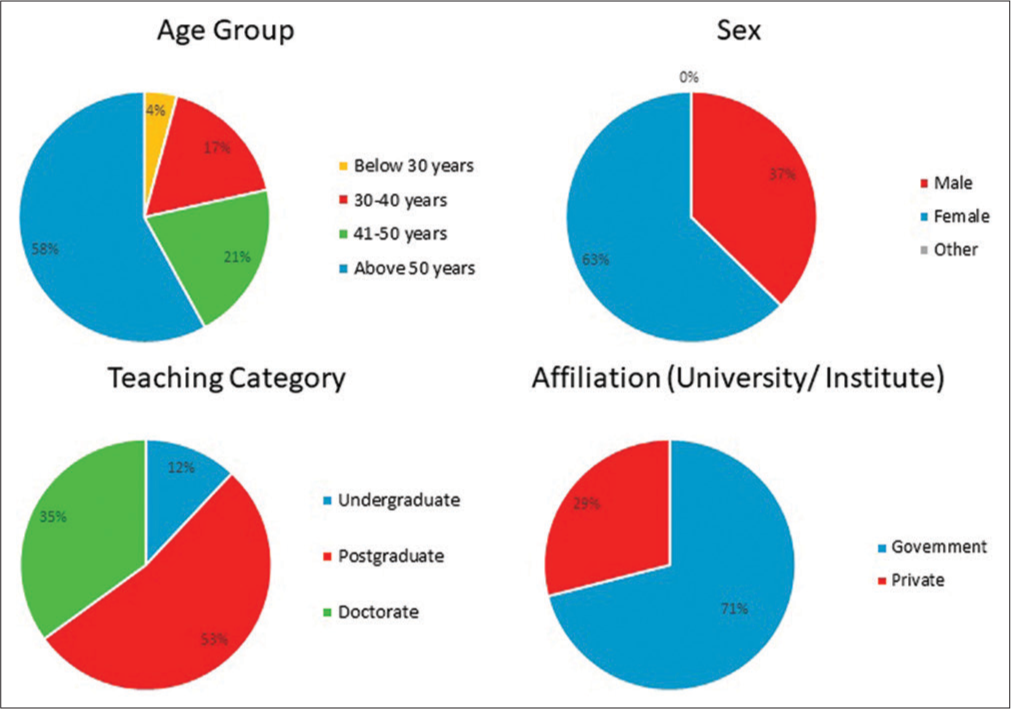
- Teacher’s background.
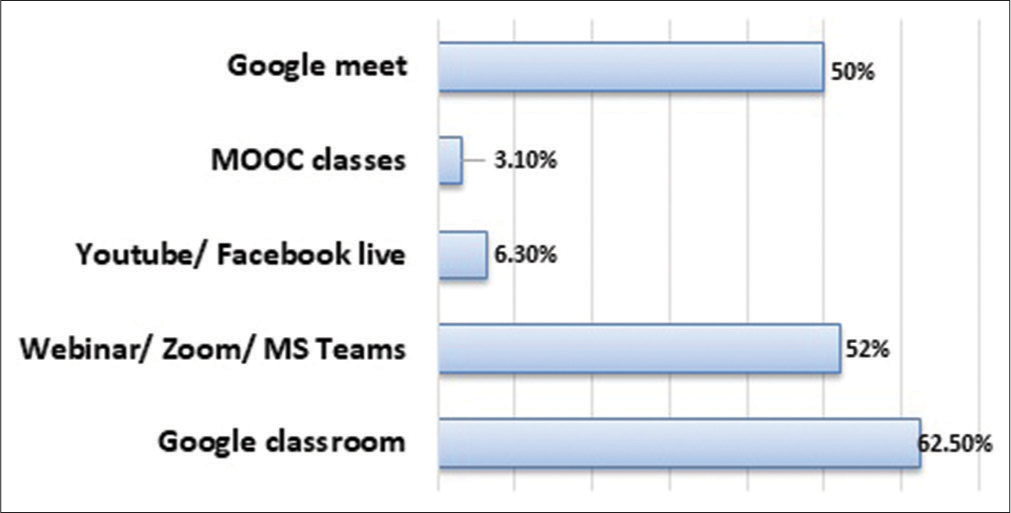
- Tools used by teachers for online teaching. MOOC -Massive open online courses, MS - microsoft
Teachers’ experience during online teaching
Almost all respondents (98%) were having their first experience with online teaching. [Figure 3] depicts various aspects of teachers’ knowledge and experience. About 60% believed that they had sufficient computer and information technology (IT) skills to conduct online lectures but 75% of teachers preferred to have training on conducting online lectures. Most of our respondent’s technical backgrounds felt that online tools are easy to use when conducting lectures. Most of the teachers were of the opinion that their management skills improved and they gained experience while teaching online. 62.5% were happy due to the flexibility of timing but agreed that it increased their workload. Online teaching takes more time than the onsite class to effectively accomplish but they were comfortable with the home environment for online teaching. The majority of respondents did not rate online lectures higher than traditional lectures.
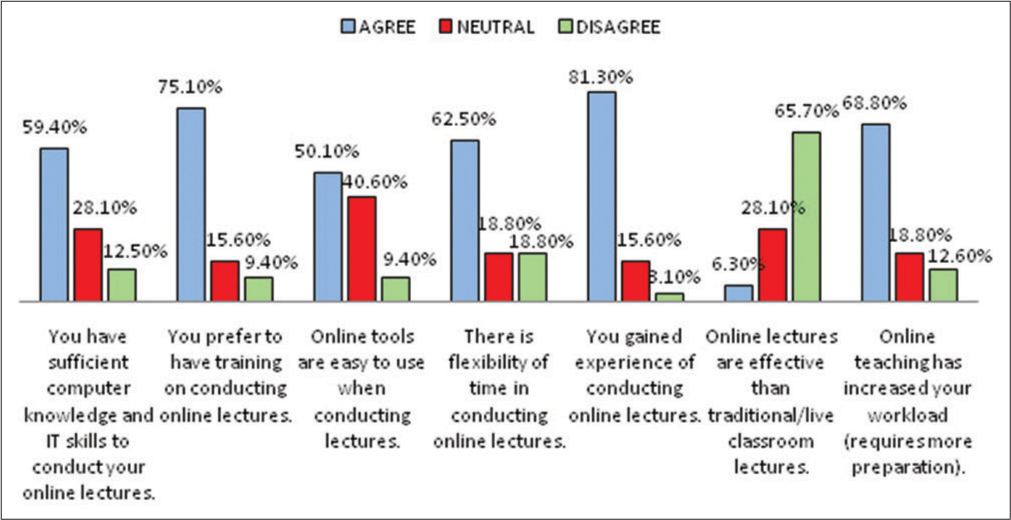
- Teachers’ knowledge and experience during online teaching.
Students’ motivation and interaction
Students’ motivation and interaction were rated low among our respondents as obvious in [Figure 4]. They felt that only sincere students take benefit of these classes, others just log in for attendance. Most of the students do not ask questions or clear their doubts. Very few felt that there was an improved relationship with the students. Most respondents believe that involving pupils from socially disadvantaged homes is difficult (69%) and internet connectivity is a problem during online classes (79%).
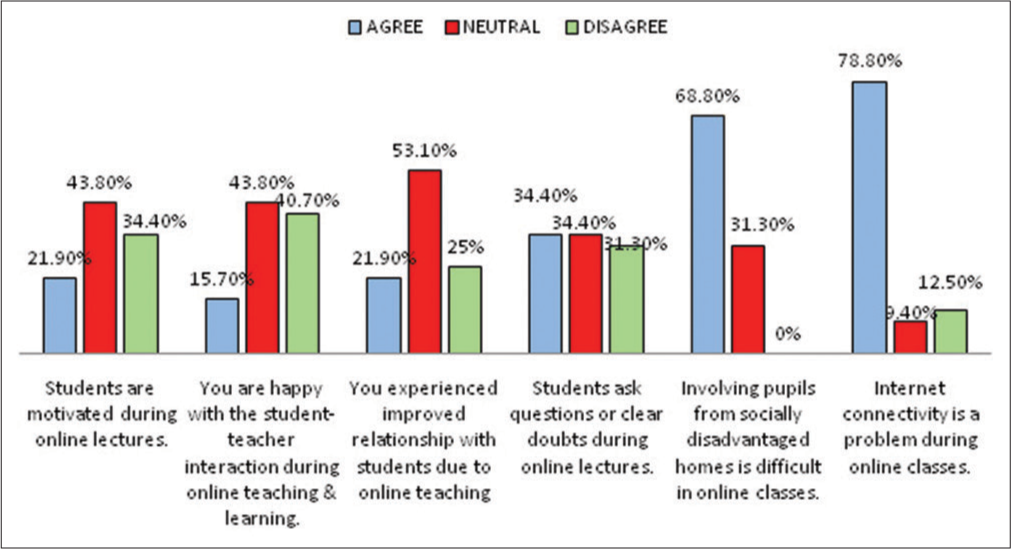
- Various aspects of students’ motivation and interaction.
Challenges and skills for online teaching
Most of the respondents agreed that there is difficulty in conducting practicals (68.80%), some subjects like Engineering drawing (59.40%) and clinical examinations [Figure 5]. They considered that innovation in teaching in the form of freedom to experiment, communication skills and body language had a great impact on the quality of teaching. A majority believed that it is better to keep classes short. Most of the respondents were not satisfied with the online assessments. Not much improvement in instructional quality was reported by the teachers in online mode.
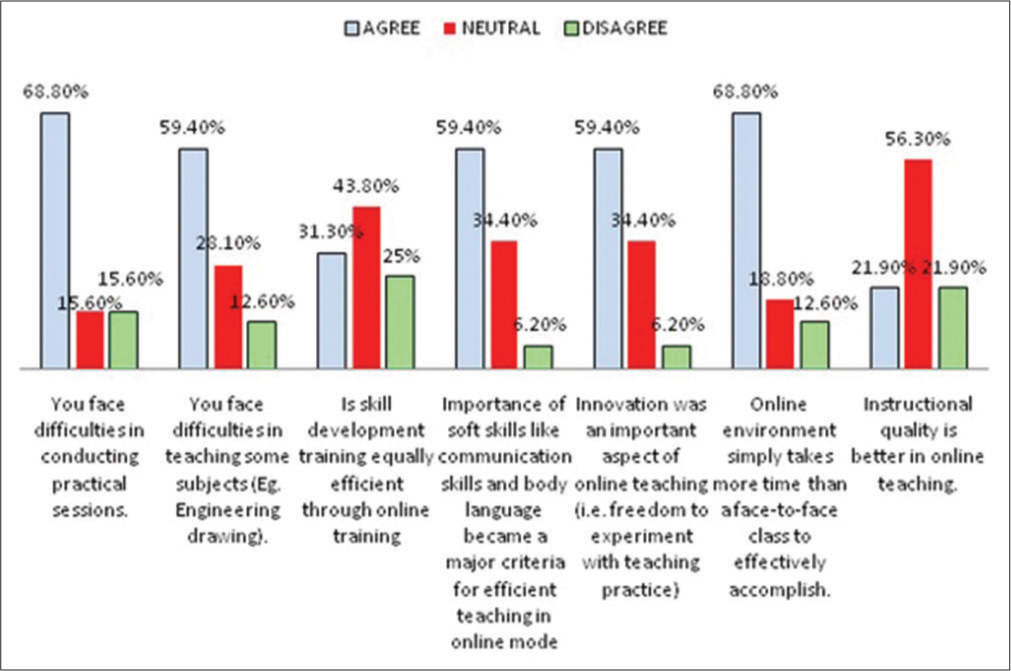
- Perception of challenges and skills during online teaching.
Teacher’s comments and feedback (Qualitative data)
Many respondents appreciated this questionnaire and considered it as an opportunity to express their views. They expressed interest in the findings of this study and complemented the survey questionnaire. Some of the comments received by the participants are shown in [Table 1].
Comments on questionnaire:
Comments on the online teaching and learning process:
Comments addressing difficulties:
|
DISCUSSION
As obvious from the responses, 98% of teachers had their first experience of online teaching. Their main focus was on the technology associated with teaching online. As our respondents belonged to higher education, about 60% believed that they had required computer and IT skills to conduct online lectures. Still, they believe instruction on how to use a particular online platform is more important than other pedagogical issues. Teaching online was a huge learning experience for most of them. Teachers, especially those above 50 years of age were not very comfortable handling technology. This challenge was overcome as various workshops were organised to train the teachers on online platforms. This is quite obvious from our survey that 75% of teachers preferred to have training in conducting online lectures.
Various challenges faced by the teachers were educational aids to be used and how to incorporate them in online mode.[12,13] In the online mode, the teacher is much more of a ‘facilitator’ of the learning process.[14] The students are not dependent on the teacher for knowledge as there is easy access to data on the internet. Learning is more collaborative, contextual and active with improved technology.[15]
Communication skills were cited as important by many teachers. The teaching methodologies need to be incorporated with the technology. Teachers think that knowledge and communication are even more important in online teaching since apart from students the audience can be their parents or other faculty members. They had to devote more time to preparing their online courses. Our respondents also agreed that online teaching has increased their workload. Maintaining work-life balance was another challenge faced.
Most of the respondents agree that they face difficulty in conducting certain classes such as clinical examinations and practicals. For an English teacher, assessing the four language skills during online classes was a challenge.
Online classes helped in handling a large number of students. Students being tech-savvy have adopted online teaching very comfortably. They were of great technological help during the classes, guiding teachers when they get stuck. Many teachers feel that they have successfully begun their second inning as a teacher.
Student-teacher interaction is an important component of effective teaching. Students’ motivation and student-teacher interaction were rated low among our respondents. The experiences of classroom teaching are well enjoyed by the students. They remember the gestures, expressions, and nuances of the teacher.[16-20] This is missing in the online mode. To increase the interest level of students, online educational tools need to be explored. Maintaining the attendance of students was a major challenge. Students log in but their presence is difficult to check by the teachers. Our respondents believe that soft skills like communication skills and body language are major criteria for efficient teaching in online mode. They also agreed that innovation, i.e., freedom to experiment with teaching practice along with the flexibility of timing, can definitely improve teaching quality.
In the present study, both students and teachers were having difficulties with the technology; mainly the internet connectivity. Students were unable to join the classes or got disconnected in the middle. As continuity could not be maintained, the students lost interest in the classes. Teachers felt frustrated when they were not able to connect.
Even in developed nations, there are some low-pay students who do not have access to broad bands and are unable to use computerised learning.[13] A similar situation is faced by Indian students due to a deficiency in high-speed internet and digital gadgets. Even the advanced educational institutions in India are ill-equipped with digital facilities right now to cope with a sudden change. The same is reflected in our results where 71% of respondents agreed that involving pupils from disadvantaged homes was difficult. However, efforts are on to come up with a solution for this digital divide.[1] Educational institutions need to improve their information technology infrastructure to meet such situations.
It was believed that regardless of the method of delivery, students give more importance to activities that were to be assessed and assigned the highest marks or credits.[12,21] As quoted by an experienced online teacher, ‘…If an online activity is not assessed, it usually does not get done….’. Different modes of online assessments were introduced during this period but most of our respondents were not satisfied with them. They think that online assessment does not reveal genuine results as cheating is prevalent. More effective means need to be devised to overcome this. If students are smart, teachers need to be smarter.
Future perspectives
Education is constantly evolving and the lockdown has given opportunities to both students and educators to explore online education.[22] Use of technology in day-today activities especially teaching had to be re-explored for online classes. The participants’ valuable experiences helped the researcher to understand their perceptions of online teaching.
The government everywhere has taken steps to ensure that the academic activities do not suffer during the lockdown period.[1] The Information Communication Technologies initiative of the Ministry of Human Resource Development combines all digital resources for online education. Some of the national online education platforms in Higher Education are Swayam, Swayam Prabha, e-PG Pathshala, etc. About 1900 courses are running for both school and higher education in all subjects. Being aware of all these platforms and taking advantage of them is the need of the hour.
A professional development programme needs to be established to help teachers to develop the necessary skills. All efforts should be made to improve internet facilities. Students should have easy access to electronic databases through the library website. Awareness of online education platforms in higher education is the need of the hour.
Strength of study
The study is significant because it highlights challenges being faced by Indian teachers in their sudden transition to online teaching in higher education. This research provides some useful suggestions for continuing and improving education.
Limitations
The survey questionnaires used in this research delimited the teachers’ responses to those areas perceived by the researcher to be important.
CONCLUSION
Although online teaching can cater a large group of students, it has several limitations. Lack of students’ motivation, limited student-teacher interaction and internet connectivity issues were the major challenges.
Declaration of patient consent
Patient’s consent not required as there are no patients in this study.
Conflicts of interest
There are no conflicts of interest.
Financial support and sponsorship
Nil.
References
- Impact of pandemic Covid-19 on education in India. Int J Curr Res. 2020;12:12582-6.
- [CrossRef] [Google Scholar]
- Learning in times of lockdown: How Covid-19 is affecting education and food security in India. Food Secur. 2020;12:793-6.
- [CrossRef] [PubMed] [Google Scholar]
- Technology-related knowledge, skills, and attitudes of pre-and in-service teachers: The current situation and emerging trends. Comput Hum Behav. 2021;115:106552.
- [CrossRef] [PubMed] [Google Scholar]
- Faculty perceptions of online teaching effectiveness and indicators of quality. Nurs Res Pract. 2017;2017:9374189.
- [CrossRef] [PubMed] [Google Scholar]
- Challenges and opportunities created by Covid-19 for ODL: A case study of IGNOU. Int J Innov Res Multidiscipl Filed. 2020a;6:217-22.
- [CrossRef] [Google Scholar]
- Online teaching in India during COVID-19: Opportunities and challenges. Asian J Sociol Res. 2021;4:20-8.
- [Google Scholar]
- Instructors' perceptions of instructor presence in online learning environments. Int Rev Res Open Distrib Learn. 2016;17:82-105.
- [CrossRef] [Google Scholar]
- Qualitative insights from a Canadian multi-institutional research study: In search of meaningful e-learning. Can J Sch Teach Learn. 2014;5:10.
- [CrossRef] [Google Scholar]
- Current trends in systematic program evaluation of online graduate nursing education: An integrative literature review. J Nurs Educ. 2012;51:570-6.
- [CrossRef] [PubMed] [Google Scholar]
- Overview and perspectives In: Computer-mediated Communication and the Online Classroom. Cresskill NJ: Hampton Press. Inc.; 1995. p. :1-10.
- [Google Scholar]
- Misconceptions and realities about teaching online. Sci Eng Ethics. 2005;11:329-40.
- [CrossRef] [PubMed] [Google Scholar]
- Medical and surgical education challenges and innovations in the COVID-19 era: A systematic review. In Vivo. 2020;34(3 Suppl):1603-11.
- [CrossRef] [PubMed] [Google Scholar]
- Teacher and Student Perceptions of Online Instructional Methodology in Higher Education: An Explanatory Mixed-method Study. 2003. :156. Available from: https://digitalcommons.lsu.edu/gradschool_dissertations/156 [Last accessed on 2023 Apr 14]
- [Google Scholar]
- Comparison of online teaching and face-to-face teaching. Proc Soc Behav Sci. 2013;89:445-9.
- [CrossRef] [Google Scholar]
- Creating effective student engagement in online courses: What do students find engaging? J Sch Teach Learn. 2010;10:1-13.
- [Google Scholar]
- Developing an asynchronous course model at a large, Urban university. J Asynchronous Learn Netw. 1998;2:1-14.
- [CrossRef] [Google Scholar]
- Perceptions of medical students towards online teaching during the COVID-19 pandemic: A national cross-sectional survey of 2721 UK medical students. BMJ Open. 2020;10:e042378.
- [CrossRef] [PubMed] [Google Scholar]
- The role of interactivity in student satisfaction and persistence in online learning. J Online Learn Teach. 2014;10:314-24.
- [Google Scholar]
- Student-content interactions in online courses: The role of question prompts in facilitating higher-level engagement with course content. J Comput Higher Educ. 2011;23:157-86.
- [CrossRef] [Google Scholar]
- Researching internet-based populations: advantages and disadvantages of online survey research, online questionnaire authoring software packages, and web survey services. J Comput Mediat Commun. 2005;10:JCMC1034.
- [CrossRef] [Google Scholar]
- Online learning during lockdown period for covid-19 in India. Int J Educ Res. 2020b;5:82-92.
- [CrossRef] [Google Scholar]






